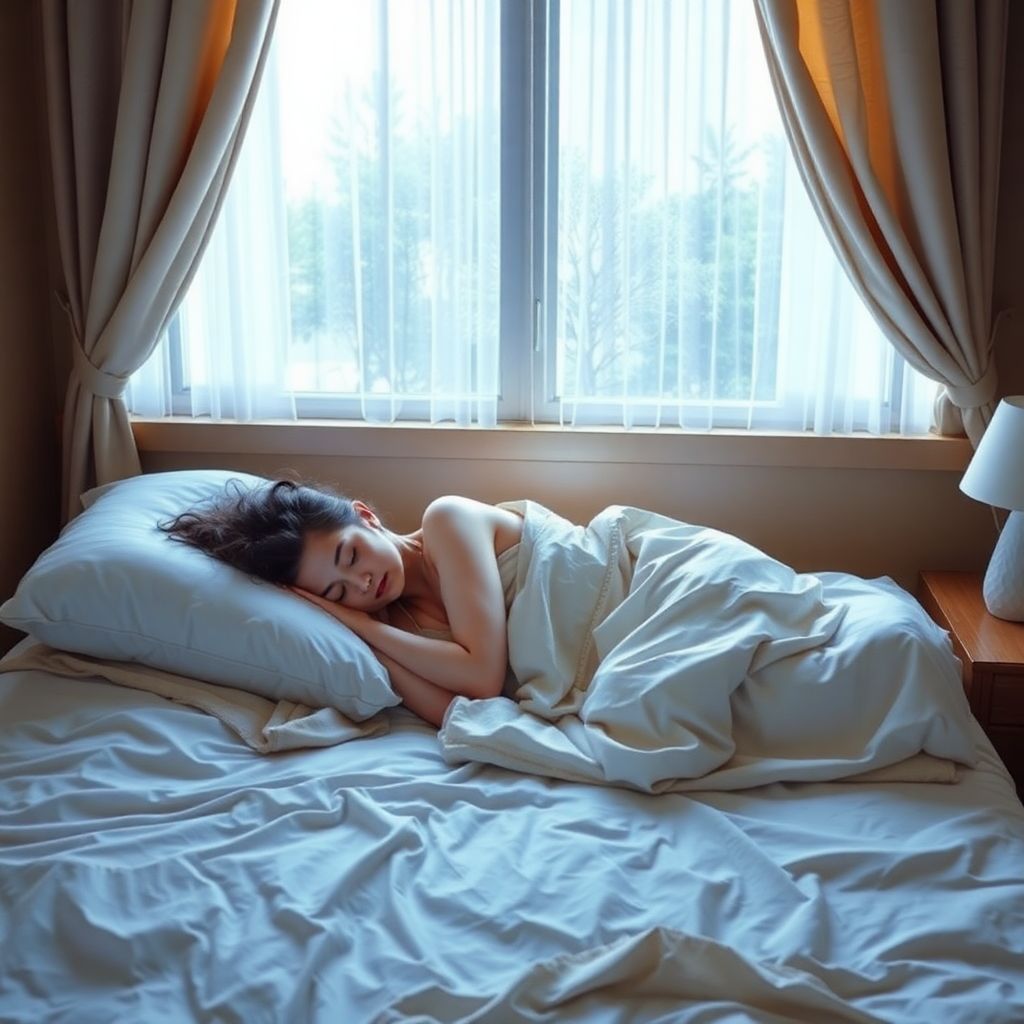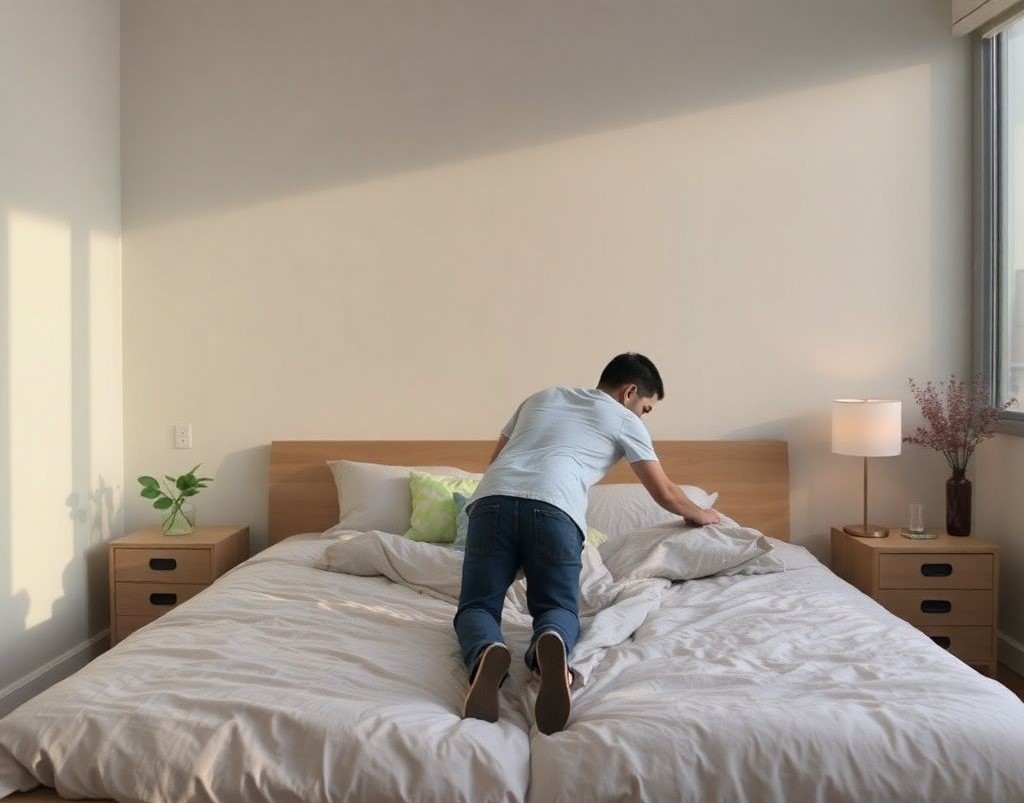Best Direction to Sleep Scientifically: North or South?
Have you ever wondered if the direction you sleep affects your health? It’s a fascinating question that bridges ancient wisdom and modern science. Many traditional practices like Vastu Shastra claim that sleep direction significantly impacts our wellbeing—but what does science actually say about this?
Recent research has begun to explore surprising connections between sleep direction and our body’s functions during rest.
In this guide, we’ll break down what science really says about sleep direction, and give you practical tips to improve your sleep quality.
The Science Behind Sleep Direction

The concept of directional sleeping connects to how our bodies interact with Earth’s magnetic field—a natural phenomenon measuring between 25 and 65 microteslas that does more than just guide compass needles.
The Cryptochrome Connection
Scientists have discovered that humans possess specialized proteins called cryptochromes in our retinas. These proteins, similar to what helps birds navigate during migration, may allow us to sense magnetic fields. Research suggests they could play a role in regulating our circadian rhythms—the internal clock governing our sleep-wake cycles.
The Pineal Gland Factor
Your pineal gland—often called the “third eye” in traditional medicine—produces melatonin, the hormone responsible for healthy sleep patterns. Some research indicates that this gland may be sensitive to electromagnetic fields, suggesting sleep direction could potentially influence melatonin production.
The Cultural and Historical Context of Sleep Direction
The concept of sleep direction isn’t new – it has roots in various cultural and historical practices around the world. Understanding these can provide interesting insights into our modern exploration of sleep direction:
Vastu Shastra
This ancient Indian system of architecture and design includes guidelines for sleep direction. According to Vastu, sleeping with your head pointing south or north is considered optimal, as it aligns your body with the Earth’s magnetic field.
Feng Shui
In this Chinese practice, sleep direction is believed to affect the flow of energy or “chi” in your bedroom. The recommended direction can vary based on person factors, but generally, sleeping with your head pointing south or east is considered favorable.
Native American Traditions
Some Native American tribes have traditions of aligning their sleeping areas with the cardinal directions. For example, in some Navajo practices, sleeping with your head to the east is believed to promote harmony with nature.
Medieval European Beliefs
In medieval Europe, there was a belief that sleeping with your head pointing east (towards Jerusalem) was spiritually useful. This practice was often reflected in the design of churches and monasteries.
Optimal Sleep Directions: What Research Shows
North-South Alignment: The Ideal Position
Traditional Vastu Shastra recommends sleeping with your head pointed either north or south, and modern research provides interesting support for this ancient wisdom. When you sleep along the north-south axis, your body aligns with Earth’s magnetic field lines. Studies suggest this alignment may offer several benefits:
- Enhanced deep sleep quality
- More stable blood pressure readings
- Improved hormonal balance
- Waking up feeling refreshed
Many practitioners specifically recommend avoiding sleeping with your head pointing north (in the Northern Hemisphere) due to potential magnetic interference with your body’s natural processes. Instead, sleeping with your head pointing south may provide optimal benefits according to this theory.

East-West Direction: A Viable Alternative
If your bedroom layout doesn’t accommodate north-south alignment, east-west orientation offers a practical alternative. While not considered optimal in traditional practices, many people report satisfactory sleep quality in this direction. Some research suggests that east-west sleeping may help:
- Maintain consistent sleep patterns
- Support natural wake cycles
- Provide stable rest quality
Creating Your Optimal Sleep Environment
Finding True North
The first step in optimizing your sleep direction is accurately determining true north in your bedroom. While traditional compasses work, modern technology offers more precise options:
For Android users:
- Compass Galaxy provides accurate readings
- Takes into account magnetic interference
- Offers easy-to-follow calibration
For iPhone users:
- The built-in Compass app works well
- Regular updates ensure accuracy
- Simple interface for quick measurements
Important: Take multiple readings from different spots in your room, staying away from large metal objects or electronics that might interfere with the measurements.
Positioning Your Bed

Once you’ve determined true north, it’s time to optimize your bed position. Consider these factors:
- Room Layout Considerations
- Ensure proper circulation space
- Account for door and window positions
- Consider natural light patterns
- Support and Stability
- Use a sturdy bed frame (our guide to quality metal frames can help)
- Ensure the mattress is properly supported
- Check floor stability in the new position
- Practical Accessibility
- Maintain easy access to both sides of the bed
- Consider placement of bedside tables
- Account for electrical outlet locations
Creating a Complete Sleep Sanctuary
While direction is important, it’s just one aspect of optimal sleep. Consider these additional factors:
Temperature Control
The ideal sleeping temperature falls between 65-68°F (18-20°C). Consider investing in a cooling mattress pad if you tend to sleep hot.
Sound Management
A quiet environment is crucial for quality sleep. If ambient noise is an issue, explore our recommended white noise machines for creating a peaceful atmosphere.
Light Control
Manage light exposure with:
- Blackout curtains
- Strategic bed placement relative to windows
- Minimal use of electronic devices before bed
Monitoring Your Results
The true test of any sleep optimization strategy is how it affects your rest. Give your new sleep direction at least 2-3 weeks before making any judgments. During this time, pay attention to:
- Sleep Quality Indicators:
- How quickly you fall asleep
- Number of nighttime awakenings
- Morning energy levels
- Dream recall and quality
- Physical Wellbeing:
- Morning aches or stiffness
- Overall energy throughout the day
- Mental clarity and focus
We recommend using a sleep tracking device to gather objective data. Our sleep tracking guide can help you choose the right option.
Common Challenges and Solutions
Limited Room Configurations
Working with a challenging room layout? Try these solutions:
- Diagonal Placement
- Can help achieve better alignment
- Maximizes available space
- May require creative furniture arrangement
- Partial Alignment
- Focus on getting as close to ideal as possible
- Consider seasonal adjustments
- Balance direction with practical needs
EMF Considerations
Modern environments present unique challenges to traditional sleep practices. Address electromagnetic field exposure by:
- Managing Electronics
- Keep devices away from your bed
- Consider using grounding sheets
- Create a device-free zone around your sleeping area
- Natural Solutions
- Use EMF-blocking materials. You can also test the levels of EMF in your bedroom using specialized devices available on Amazon
- Incorporate grounding practices
- Maintain distance from large electrical appliances
Beyond Direction: Holistic Sleep Optimization
While sleep direction is important, it works best as part of a comprehensive approach to your overall sleep health. Consider these complementary practices:
- Consistent Sleep Schedule
- Go to bed and wake up at the same time
- Develop a relaxing bedtime routine
- Manage light exposure throughout the day
- Supportive Sleep Environment
- Choose the right pillow for your sleep style
- Invest in quality bedding
- Maintain proper room ventilation
- Lifestyle Factors
- Regular exercise (but not too close to bedtime)
- Mindful eating habits
- Stress management techniques
For a complete guide to optimizing your sleep environment, check out our article on creating a sleep-friendly bedroom.
When to Seek Professional Help
While optimizing sleep direction and environment can significantly improve rest quality, persistent sleep issues may require professional attention. Consider consulting a sleep specialist if you experience:
- Chronic insomnia
- Excessive daytime sleepiness
- Regular sleep disturbances
- Sleep apnea symptoms
For natural approaches to try first, explore our comprehensive guide on how to sleep better at night naturally.
The Bottom Line
The ancient wisdom of directional sleeping finds interesting support in modern scientific research. While sleep direction alone won’t solve all rest-related issues, it can be an important part of optimizing your sleep environment. Combined with good sleep hygiene and attention to other environmental factors, proper sleep direction may help you achieve the quality rest you deserve.
Remember that individual responses vary, and what works best for one person may not be optimal for another. Pay attention to your body’s signals and adjust accordingly. For more comprehensive sleep optimization strategies, explore our guide to establishing a healthy sleep routine.
Frequently Asked Questions
What is the best direction to sleep according to science?
While research is ongoing, some studies suggest that sleeping with your head pointing north may align your body with the Earth’s magnetic field, potentially improving sleep quality. However, more research is needed to confirm these findings conclusively.
Can sleeping direction affect health?
Some theories suggest that sleep direction may influence various aspects of health, including blood pressure and melatonin production. However, scientific evidence is limited, and sleep direction should be considered alongside other important factors like sleep hygiene and duration.
Which direction is not correct to sleep in?
Some claim the worst direction to sleep in is south (head facing south) due to possible blood-pressure impacts, while others say a north orientation could increase stress. Ultimately, it varies by tradition and personal response.
How do I find true north in my bedroom?
You can use a compass or smartphone app to decide true north in your bedroom. Popular apps include Compass Galaxy for Android and Compass for iPhone on iOS.
Take many readings to confirm accuracy.
What is the scientifically best position to sleep?
Research suggests a medium-firm mattress, side or back sleeping posture, and a north-south orientation might help. However, there’s no unanimous scientific verdict.
What if I can’t align my bed perfectly north-south?
If perfect north-south bed alignment isn’t possible because of room layout or other constraints, east-west orientation is often considered the next best option. The key is to experiment and find what works best for you while maintaining overall sleep comfort.
While sleeping, in which direction should the head be?
When sleeping, try facing the head in either the north or south direction. If that’s impossible, aim for east-west. Focus on the orientation that feels best over a 2–3 week trial.
Does sleep direction affect dreams?
While there’s no scientific consensus, some people report experiencing different types of dreams depending on their sleep direction. Keeping a dream journal can help you track any potential correlations between sleep direction and dream content.
Can sleep direction help with insomnia?
While sleep direction alone is unlikely to cure insomnia, some people report improved sleep quality when changing their bed orientation. It’s worth experimenting with as part of a comprehensive approach to addressing sleep issues.
How long should I try a new sleep direction before deciding if it works?
It’s recommended to maintain a new sleep direction for at least 2-3 weeks to allow your body to adjust and to gather enough data to notice any potential effects on your sleep quality or overall well-being.
Is there a connection between sleep direction and the Earth’s magnetic field?
Some researchers theorize that aligning our sleep direction with the Earth’s magnetic field could influence our body’s internal processes. However, more scientific studies are needed to confirm this connection and it’s potential effects on sleep.
Can sleeping with head facing south lower blood pressure?
Some studies link head facing south while sleeping to slightly lower blood pressure, but the evidence remains limited.
Can sleep direction affect melatonin production?
Some studies suggest that sleep direction may influence melatonin production, particularly when aligned with the Earth’s magnetic field. However, more research is needed to fully understand this relationship and its implications for sleep quality.
Are there any risks to changing my sleep direction?
Changing your sleep direction is generally considered safe. However, it’s important to maintain overall sleep comfort and not sacrifice other aspects of good sleep hygiene in the process of experimenting with direction.
